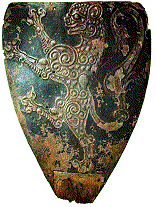Norman shield

The now known as kite shield , also almond , hang-gliding , Langspitz- or Kiteschild (of English. Kite "dragon"), known protective weapon was in the 11th and 12th centuries the dominant type of shield in Europe.
development
The Norman shield developed from the round shield , which was extended downwards in order to offer greater protection, especially for riders. However, this type of shield was also used by foot fighters.
Form and handling
The examples shown on the Bayeux Tapestry are elongated shields tapering downwards with a rounded upper edge. The height varies in different representations. However, a height of 50 to 75% of the height of the wearer can be assumed. The size of the shields benefited the shield wall defense formation, as can also be seen in depictions on the Bayeux Tapestry.
A curved shape can be seen in many depictions, but the use of shields as a food pad on the Bayeux Tapestry also indicates that there were shields with only a very slight curve.
Many Norman shields had a shield boss that varied in size, but here, unlike the round shield, in which it protected the hand on the handle, only had a decorative effect.
To hold the shield either square or crossing leather straps were attached. In addition, a shield shackle contributed to better handling.
Representation in historical sources

The naming Normannenschild can be traced back to the Bayeux Tapestry , which depicts this type of shield in large numbers. This carpet shows the Norman conquest of England in 1066. However, this name has only appeared in recent times, the Norman shield was by no means only used by the Normans. Other sources from the 11th-12th centuries Century show Norman shields, for example the Codex aureus Epternacensis from the early 11th century or the illustrated chronicle Liber ad honorem Augusti sive de rebus Siculis from 1196.
Finds
There are currently no unambiguous finds of this type of shield. Whether the so-called rider's shield from Seedorf (Switzerland) from the late 12th century, which is kept in the Swiss National Museum in Zurich , is merely a modified form of the almond shield, is disputed today. Earlier treatises report that it was incomplete and originally preserved, that almost a third of the upper part was cut off in the 13th century . This thesis was put forward mainly because the folded upper edge of the rawhide covering has a round shape. In 1990, further investigations were carried out which showed that the upper edge does not differ from the side edges in terms of the preparation and fastening of the covering or the painting. It was also noticeable that the covering, if it were to have covered a sign with a round upper edge, would only have closed it flush. However, the top edge is one of the most stressed areas on the shield, so wrapping is very important. These findings make it very unlikely that this shield was originally a Norman shield.
gallery
Markward von Annweiler with a Norman shield and coat of arms ( Liber ad honorem Augusti sive de rebus Siculis , 1196)
So-called Temple Pyx (monstrance), part of a reliquary (around 1140–1150), today the Burrell Collection , Glasgow .
Web links
Individual evidence
- ↑ Jan Kohlmorgen: The medieval equestrian shield . Karfunkel-Verlag, Wald-Michelbach 2002, ISBN 3-935616-10-4 , p. 48 ff .





